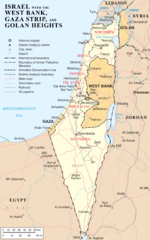Hudna
From Wikipedia, the free encyclopedia
|
Part of a series on the |
|
| Fields | |
Hudna (هدنة) is an Arabic term meaning a temporary "truce" or "armistice" as well as "calm" or "quiet", coming from a verbal root meaning "calm". It is sometimes translated as "cease-fire". In the Lisan al-Arab (Ibn al-Manzur's definitive dictionary of classical Arabic, dating to the 14th century) it is defined as follows:
- "hadana: he grew quiet. hadina: he quieted (transitive or intransitive). haadana: he made peace with. The noun from each of these is hudna."
A particularly famous early hudna was the Treaty of Hudaybiyyah between Muhammad and the Quraysh tribe.
According to Umdat as-Salik, a medieval summary of Shafi'i jurisprudence, hudnas with a non-Muslim enemy should be limited to 10 years: "if Muslims are weak, a truce may be made for ten years if necessary, for the Prophet made a truce with the Quraysh for that long, as is related by Abu Dawud" ('Umdat as-Salik, o9.16).
[edit] Hudna in the Israeli-Palestinian conflict
In English, the term is most frequently used in reference to a cease-fire agreement in the Israeli-Palestinian conflict, particularly one that would involve organizations such as Hamas. The concept of hudna was introduced to the conflict by the Israeli businessman Eyal Erlich in 2001, after seeing a hudna being declared in order to calm a feud in Jordan (cf. Haaretz, January 2, 2002); he and some others proposed, unsuccessfully, that Israel should suggest a mutual hudna as a prelude to a more lasting peace.
Despite the Israeli government's rejection of the idea, in summer 2003 — following pressure from Abu Mazen and Egypt — Hamas and Islamic Jihad unilaterally declared a 45-day ceasefire, or hudna. Its proponents commonly argued that such a cease-fire would allow hostility to die down and make a full reconciliation possible; its opponents commonly argued that it would be a mere tactical maneuver enabling Palestinian groups to re-group and muster their strength in preparation for further attacks on Israelis, or Israel to continue expanding settlements, blockading Palestinian towns, and arresting members of such groups[1]. The hudna started in late June 2003.
In an IDF operation to arrest Hamas bomb-makers gunfight broke out in which an Israeli soldier and two alleged Hamas militants were killed. Hamas responded with a suicide bombing on August 12, killing one Israeli civilian. Fatah claimed responsibility for a second suicide bombing on August 12 killing another Israeli citizen. Despite this de facto violation of the hudna, Hamas stated that the cease-fire would continue. Hostilities then escalated: the Israeli army killed Islamic Jihad's Muhammad Seeder on August 14; the Jerusalem bus 2 massacre by Hamas and Islamic Jihad on August 19, killed 23 and wounded 136 people ; and Israeli forces killed Hamas's Isma'il Abu-Shanab on August 21. After the killing of the two high-ranking leaders, Hamas eventually called off the hudna[2].
In January 2004, senior Hamas leader Abdel Aziz al-Rantissi offered a 10-year hudna in return for complete withdrawal from all territories captured in the Six Day War, and the establishment of a Palestinian state in the West Bank and Gaza. Rantissi said the hudna was limited to ten years and represented a decision by the movement because it was "difficult to liberate all our land at this stage; the hudna would however not signal a recognition of the state of Israel." Hamas' then leader, Sheikh Ahmed Yassin, made similar statements at this time, including a one hundred year Hudna[citation needed]. Yassin was killed by Israel in March 2004, Rantissi in April[3].
[edit] See also
- Taqiyya
- Al-Aqsa Intifada
- Hamas
- History of Islam
- List of Islamic terms in Arabic
- Muhammad
- Tahdia
- The Israeli-Palestinian conflict




